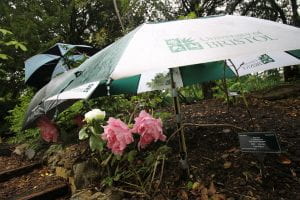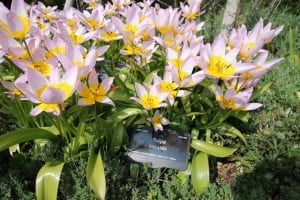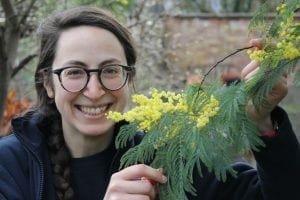By Andy Winfield
How did it get to be May already? It seems a very short time ago that we were looking at the low sun and listening to the lone robins sing, bare earth and branches waiting for a temperature hike. Well, the Garden has plumped up with leaves and life, almost fluorescent in its vibrancy. It’s a wonderful time of year, even when it rains you can almost see the plants growing.
 While the rain is soaking into the May soil, it also threatens the flowers of one group of plants in our Chinese Herb Garden. This year we have completed our peony garden, a unique display here in the west country, and on Sunday 12th May we’re holding a day dedicated to peonies in celebration. One thing we’d like for people to see in this area is of course the flowers of peonies, and the weather was doing its best to rain on our peony parade. So we decided to pamper these plants with an umbrella each. It might seem over the top, but it’s a treatment that some of them are accustomed to. In days gone by the gansu mudan peony has led a life of privilege; ancient China knew it as the Emperor’s flower and law decreed that it was only grown in his gardens. Specialist growers were tasked with cultivating it for use in the imperial borders, but if anyone got ideas above their station and sneaked some in their own garden, well, they were executed! So some of these peony flowers have the air of ‘an umbrella is no more than I deserve’.
While the rain is soaking into the May soil, it also threatens the flowers of one group of plants in our Chinese Herb Garden. This year we have completed our peony garden, a unique display here in the west country, and on Sunday 12th May we’re holding a day dedicated to peonies in celebration. One thing we’d like for people to see in this area is of course the flowers of peonies, and the weather was doing its best to rain on our peony parade. So we decided to pamper these plants with an umbrella each. It might seem over the top, but it’s a treatment that some of them are accustomed to. In days gone by the gansu mudan peony has led a life of privilege; ancient China knew it as the Emperor’s flower and law decreed that it was only grown in his gardens. Specialist growers were tasked with cultivating it for use in the imperial borders, but if anyone got ideas above their station and sneaked some in their own garden, well, they were executed! So some of these peony flowers have the air of ‘an umbrella is no more than I deserve’.
(more…)
 This week the commemoration of the 75th anniversary of D-Day was observed in Northern France by veterans, world leaders and politicians. Even though the second world war was so long ago, its echoes still reverberate. The operation needed 156,000 troops with 73,000 from the US. So, in the lead up to the invasion, thousands of American GIs were stationed across the South West and many throughout the areas of Bristol. (more…)
This week the commemoration of the 75th anniversary of D-Day was observed in Northern France by veterans, world leaders and politicians. Even though the second world war was so long ago, its echoes still reverberate. The operation needed 156,000 troops with 73,000 from the US. So, in the lead up to the invasion, thousands of American GIs were stationed across the South West and many throughout the areas of Bristol. (more…)



